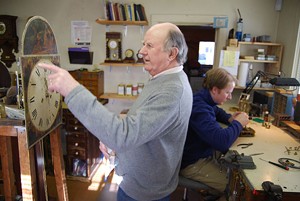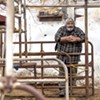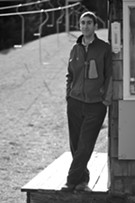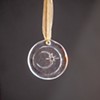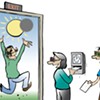Published December 26, 2007 at 1:49 p.m.
The home and workshop of Ray Bates, “The British Clockmaker,” is not hard to find. It’s the only white colonial in Newfane with a giant Union Jack painted on the door. But you don’t just drop by for a visit — he’s got a six-month backlog and keeps the place locked tight to prevent tourists from wandering in. It’s too bad, because on the other side of the door are some of the oldest, most ornate clocks on the planet, and a distinguished gentleman with a Scottish lilt, pale blue eyes and a deep well of mechanical, and aesthetic, skill.
Bates is a Master Clockmaker, which means he endured a rigorous five-year apprenticeship in his hometown of Edinburgh, obtained a degree in mechanical engineering, and wrapped it all up by crafting a masterpiece clock. His principle task these days is to restore antique clocks, and in clock-speak, “antique” means that the time-keeping device predates the Industrial Revolution. Bates says the earliest clocks were made in Italy, sometime around the 14th-century.
Needless to say, you can’t go out and buy parts for 300-year-old clocks, so Bates crafts the inner workings out of brass and steel. The oldest clock in his shop is from 1690, and it hangs on the wall like most of the others; small and unassuming, the slightly frayed ropes barely hint at its advanced age.
Asked how he got into this arcane profession, Bates haltingly calls forth a memory as if no one’s ever asked him the question before: When he was 6 years old, he took apart a Japanese alarm clock and put it back together again correctly. “Oh, yes,” he says with apparent surprise, “that’s . . . right!” Bates’ innate mechanical curiosity was pushed along by his father, an electrical engineer. “He and I used to build our own radios and do all kinds of experimenting,” he recalls. Then Bates got into model airplanes, constructing them as if they needed to safely transport mini-people. “I was a real stickler for details,” Bates recalls. “They had to be perfect and proportionate.”
Attention to detail is crucial in a clockmaker, but other abilities are even more so, according to Bates, who in his studio is surrounded by moon-faced, convex wall clocks, stately, burnished grandfathers, boxy marine chronometers, slender barometers and high-resolution photos of clock faces with celestial motifs. “The most important skill, apart from the obvious one of fine motor control, is patience,” he instructs. “If you don’t have patience, you can’t do this type of work. You’ve got to be able to tolerate the dirty work that other people have done to the clock that makes you furious. You have to have a respect for history and knowledge of the processes that were used 300 years ago. And you have to be able to, in a sense, communicate with the man who made the clock — you have to get into his brain.”
But to get to the essence of the device, its etymology is helpful. The word “clock” comes from the French word “cloche,” or bell. The first clocks didn’t have dials or hands; they struck bells to summon people to prayer. These primitive mechanisms replaced the watchman, Bates explains, “because he often got drunk and fell asleep.” As society got more complex, it needed more sophisticated ways of measuring time, and one look behind the visage of a clock from the late 18th century reflects the trend: Brass gears mesh with tiny pinions, delicate springs engage wheels and disks, and it all goes ’round with a synchronous inevitability.
The clockmaker’s privilege, therefore, is to be the god in the machine.
Bates also repairs barometers, altimeters and compasses — essential navigational tools. Flanking the mantle in his workshop are two FitzRoy barometers circa 1870, invented by Robert FitzRoy, who was the captain of the HMS Beagle when it carried Charles Darwin. The pieces are long and lean — simple-looking, actually — with mercury pent up in a glass tube. The mercury is surrounded by fine gradients indicating barometric pressure, and it’s all contained in a wood case, giving it a museum-like appearance. That the device is almost 140 years old, yet accurately displays the pressure, is a testament to the integrity of its design, and the acumen of its animator. Bates is modest about his role as keeper of space, time and weather, but it makes perfect sense to combine the jobs: If you don’t get lost, or caught in a storm, you’re less likely to be late.
The irony is that Bates himself is not known for being punctual. “What some people wonder about me is why I’m never on time. And it’s because I refuse to be controlled by the clock,” he says with a chuckle. In addition, he’s not a collector of clocks, preferring to maintain a cool distance from the obsession that it is to some people. “I have the pleasure of working on other people’s treasures,” he admits. Those “other people” include private clients and institutions such as Harvard, Mystic Seaport, Dartmouth College and the Boston Athenaeum. Occasion-ally, he’ll even get a clock from England to restore.
Intricate as they are, the clocks Bates works on aren’t always “on time,” either. If they’re “accurate to within 5 minutes per week, that’s good enough,” he says. Their historical and aesthetic authenticity, on the other hand, is what Bates’ work is all about.
As an example, he gestures to a brass clock face on top of the mantle in his workshop. It has a silvery matte patina, with Roman numerals inlaid and coated in black wax. All around the face is gilded filigree. Bates explains that the face is from a grandfather clock dating to 1740; he took a picture of it when it came into his shop. It looked dull and grungy, worn from the stress of being an unrelieved sentinel. Bates polished it and restored the wax in the numbers, and now the silver portions of the face almost glow next to the gold. It’s easy to look at the clock and think that an artist restored it, but Bates is more of a scientist, and he understands the chemistry behind what he’s doing: “The brass is silvery because they started out with silver nitrate and converted it to silver chloride, and it’s applied with salt, which prepares the surface. The silver only sticks to the metal, not the wax, so you get a beautiful contrast.”
Another of the clockmaker’s duties is to prevent the profession’s extinction, and Bates has obliged by taking on a total of seven apprentices over the years. Five of them stuck it out to become Masters, one of whom is Bates’ son, Richard. “I trained him as if he was somebody else’s son,” Bates says. “I made him suffer.” Richard has been at it for more than 10 years now, and his father proudly acknowledges that clock making is in his son’s blood. They have workshops on separate sides of the house; Ray’s is cluttered and a little messy, while Richard’s is clean and orderly.
Richard sits at a high desk looking out on the street and the picturesque Newfane Commons, where a white church stands a hundred feet from the colonnades of the county courthouse. Behind him are dozens of clocks from around the world, including a baroque French clock made of gold and marble, an austere Austrian, and a Howard “wooden works” clock from the American Revolution, when there was an embargo on metal from Britain.
Back on the other side of the house, Bates points out a clock face with two almond-shaped holes near the top — cut-outs for eyes that move back and forth with the seconds. “So you get this eerie effect of, everywhere you are, the clock is watching you,” Bates says. “I’ve never seen another like it.”
More By This Author
Speaking of...
-

Q&A: Catching Up With the Champlain Valley Quilt Guild
Apr 10, 2024 -

Video: The Champlain Valley Quilt Guild Prepares for Its Biennial Quilt Show
Apr 4, 2024 -

Q&A: Digging Into the Remnants of the Ravine That Divided Burlington
Mar 27, 2024 -

Video: Digging Into the Ravine That Divided Burlington in the 1800s
Mar 21, 2024 -

Q&A: Repairing a Historic Smokestack From a Floating Basket
Nov 22, 2023 - More »
Comments
Comments are closed.
From 2014-2020, Seven Days allowed readers to comment on all stories posted on our website. While we've appreciated the suggestions and insights, right now Seven Days is prioritizing our core mission — producing high-quality, responsible local journalism — over moderating online debates between readers.
To criticize, correct or praise our reporting, please send us a letter to the editor or send us a tip. We’ll check it out and report the results.
Online comments may return when we have better tech tools for managing them. Thanks for reading.



































